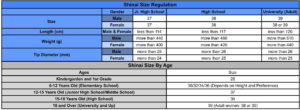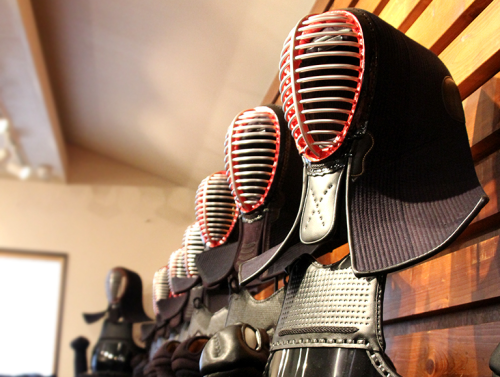How Much Does Kendo Equipment Cost?
Like American Football and Hockey, Kendo is a full body contact sport that requires several pieces of equipment. Likewise, the costs of each piece can vary a lot depending on where you look.
Here we discuss what are all the Kendo costs you will face for starting kendo. What to look at when buying equipment and its respective pricing. Adding in my personal tips along the way.
How Much Does A Shinai (Kendo Sword/Stick) Cost?
If you just started Kendo, the first thing you will be required to buy is the Shinai. A Shinai is a bamboo sword made out of 4 bamboo slats bound with leather fittings.
Before we talk about the price, let’s explain what kind of Shinais are available based on type, size, and materials.
The 3 Types of Shinai:
-
- The standard Shinai with a overall balanced weight distribution from the handle to tip.
-
- The Jissengata (Practical combat) or Dobari (Wide body) Shinai. It is light weighted at the tip with a thicker body towards the handle.
-
- The Koto/Chokuto (Straight blade) Shinai. As its name implies, it is straighter throughout the whole Shinai where the weight is more distributed towards the tip.
There are different sizes of Shinai regulated for official tournaments depending on your age group (Chart displayed below)

Shinais are mainly made from 3 types of materials – Keichiku, Madake, and carbon fiber.
Keichiku is the most common and cheapest material you will find in the current market. It is mass produced in factories from Taiwan and Indonesia, the largest Shinai manufacturing countries in the world. It is much less flexible compared to Madake and is more prone to breaking.
As mentioned. Madake is a rarer species of bamboo as it blossoms at extremely long intervals from 40 to 80 years. It is also known to be more durable while flexible at the same time, making it a more expensive choice for Shinais.
The carbon fiber Shinai is the most expensive out of the 3 types. It is known to have the strongest durability with users claimed to have used it for over 10 years. However, it is not recommended for beginners because of how different it feels compared to a bamboo Shinai. This may result in developing bad striking habits in the long term.
Shinai prices can range from $30 to $100 (USD). For your day-to-day practices, I recommend using standard practice Shinais that tend to be the most affordable option. Especially if you are practicing 3 or more times a week.
While Dobari and Koto Shinais are more suited for advanced practitioners, they are also commonly more expensive as they are more custom made products.
Tips:
Buying Shinais in bulk can cut shipping costs significantly. You could get a couple of friends who are also interested in buying to make a pool order and split it evenly.
When you break your Shinais. You should keep the slats that are still intact so that they can be reused for future repairs to extend its longevity. This is will really keep your Kendo costs to a minimum in the long run.
How Much Does Dogi (Uniforms) Cost?
A Kendo uniform consists of the Kendogi (Top) and Hakama (Bottom), which price averages from $50-$200 (USD).
The uniforms are manufactured from either 1 of 2 types of material, cotton vs synthetic fiber (aka. Tetron, Jersey, or Knit Fabric). Here is a basic chart for comparison:

You may find affordable prices for both types of uniforms, depending on the quality of processing and the materials itself.
Although synthetic uniforms are a lot more convenient. The traditional Shoaizome (Indigo blue dye) aesthetic can only be produced with cotton materials. Like wearing a suit to an interview, it is the most appropriate attire to wear to Shina (gradings), especially for higher levels.
I recommend buying a cotton uniform set for all occasions if you are just starting out. While if you practice and compete often, having an additional synthetic uniform would be ideal.
If you are looking for budget friendly options and reside in North America. E-Bogu provides affordable uniforms with sets of cotton and Tetron combinations.
Tips:
Make sure you pay close attention to the size chart from each seller. Uniform sizes can vary across businesses and you should research which measurements best matches your size.
How Much Does Bogu (Armour) Cost?
Out of all of your Kendo costs. Buying Bogu can be one of the most daunting tasks. There are many considerations to take and even the cheapest sets when ordering outside of Japan can cost well over $300 (USD).
When choosing the right set for yourself. You should start by identifying criteria such as your budget, practice frequency, and maintenance habits.
I personally have been using Kendostar’s basic “Vanguard” set which I purchased at a holiday discount of $430 (USD). It has survived very well for the 8 years I have been using it. It is very protective even against heavy blows by less experienced beginners (an experience I face quite often).
The Men (protective head gear) is also significantly lighter weighted than older models that I’ve worn so my head does not sink forward.
Aside from the need to replace worn out Himo (strings) every now and then. The only issue I deal with is the Kote’s (gauntlets) leather palms have torn out holes from wear and tear.
Which evidently is my problem from gripping my Shinai too hard over long periods of time and poor maintenance after practices (a lesson I had to learn the hard way).
Although Clarino/synthetic leather does prove to be a very durable alternative to the traditional (and more expensive) deer leather. How you care for it truly reflects how long it will last.
Tips:
Consider purchasing second hand sets online such as Ebay, Kijiji, and Etsy. Many people that have quit Kendo will sell their equipment there. You might even find entire sets, including bogu, uniforms, and Shinais altogether.
That being said, I recommend prioritizing a well fit Men and Kote. Those parts really affect your experience during practice.
Tozando provides a great article to how to measure your size accurately for purchasing the best fit Bogu.
What Other Costs Should I Expect When Practicing Kendo?
Here is an exhaustive list of some additional item you may need for practicing:
Himo (String parts for Bogu): $15 – $30 USD
An item you will only need when your existing Himo has snapped and broken.
Zekken (Name Tag): $30 – $60 USD
This is a necessary item for representing yourself as a member of the dojo you practice in. Typically your dojo help you through the process of purchasing one when you are ready.
Shinai bag: $15 – $100 USD
There a few kinds out in the market, from cloth bags to waterproof synthetic materials.
However it is not mandatory to use carrying cases specific to Kendo and you may try to find possible alternatives. I even know people that have procured fabric and leather to make their own bags.
Bogu bag: $50 – $400 USD
Bogu bags are a must have when it comes to travelling long distances with your Bogu.
Although Tailored Bogu Bags can be quite pricey, it is common practice to use multi-use travel suitcases instead.
I use an expandable carry on (size dimensions: 24.5″H x 17″W x 11″D). It fits my Bogu and Dogi very tightly with a few other personal items.
Tenugui (Head towel): $5 – $20 USD
Normally your dojo will have their own representative Tenugui you can buy/they will provide.
Shinai Maintenance tools: $20 – $50 USD
Maintenance tools can prolong your Shinais use conditions significantly, so it is ideal to have them at hand.
Although you can buy quality repair goods from Kendo supply stores. You can also check out my article on Shinai maintenance for cheaper substitutes.
Final Wrap Up
After adding up each piece of everything you need to practice Kendo, you may find that it can be quite costly. But if you are only starting Kendo. You will not have to worry about the costs immediately because you won’t be expected to buy Bogu, or even the uniform immediately and will only need them as you get better through practicing
If you ever find yourself stuck between decisions, don’t hesitate to ask the kendo community, whether it’s online or with you fellow practitioners in your dojo.
I myself have realized my preferences in using a thicker grip Shinai only because my Senpai recommended it and was kind enough to one to me for a practice. It gave me more confidence to purchase one instead of just speculating from abstract descriptions.
Feel free to email me at kendobakakun@gmail.com for any questions and I’ll reply as soon as I can!
Sources
https://kendokyoto.com/fs/minamoto/c/dougihakama-erabikata
https://yourmystar.jp/relitem/sports-item/bamboo-sword/#3
https://weblog.tozando.com/what-is-keichiku/
https://weblog.tozando.com/what-is-madake/
https://japantoday.com/category/features/lifestyle/%27once-in-a-hundred-year%27-sightings-of-bamboo-blossoms-reported-in-japan
https://www.rakuten.ne.jp/gold/kyoto-kendo/kendo_information/sinai02.html
https://www.facebook.com/ZenNiBu/posts/144508530543840/
https://californiabudogu.com/en-ca/pages/bogu-material-information
https://www.ken-pro.jp/article-2.html
https://bushizo.com/media/201906/3276/
https://zennihonbudogu.com/futon-stitching/

